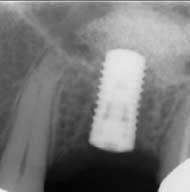 Most people, particularly in the urban area do not want a toothless smile. They would like a mouthful of teeth, in case they lose teeth on account of old age or accident or decay. A bright smile can do wonders. Older people cannot prevent aging and its effects, but with the help of the latest techniques that science has offered, they can also look good. In case, they lose out on teeth on account of tooth loss then naturally they can do in for the latest techniques that dental implantology has to offer. Sophisticated techniques are there for replacing the lost tooth.
Most people, particularly in the urban area do not want a toothless smile. They would like a mouthful of teeth, in case they lose teeth on account of old age or accident or decay. A bright smile can do wonders. Older people cannot prevent aging and its effects, but with the help of the latest techniques that science has offered, they can also look good. In case, they lose out on teeth on account of tooth loss then naturally they can do in for the latest techniques that dental implantology has to offer. Sophisticated techniques are there for replacing the lost tooth.
What are the latest dental implant techniques
Cone Beam Volumetric Technology (CBVT)
This is a type of computerized tomography which makes use of 3D imaging software for craniofacial scanning. This happens to be designed in the form of diagnostic aid for positioning implants, treatment of temporomandibular joint disorder as well as maxillofacial surgery. This is in fact is a latest technological development which has a multimodal imaging. The image quality is improved upon, particularly the contrasts of soft tissues. It also reduces the radiation levels that a patient is exposed to. It also makes use of low powered medical fluoroscopy that tends to provide a rather continuous image through scanning process. The data is derived with the help of cone shaped x-ray beam that transfers the data into solid state type of sensors for capturing images. This finally produces the final image through single rotation. This is quicker that traditional CT scanners and exposes the patient to a rather lower radiation dosage.
This new type of dental provides permanent teeth within no time. They need not feel shy of smiling. The traditional approach to getting implants fixed takes long time. Now this can be done much quicker through the CBVT method.
Root form
This happens to be the closest in both size as well as shape. These are used to replace several or few or more teeth. Once the anesthesia is given, the dentist then exposes jaw. The total number of required incisions and bone preparations would depend upon how number of implants need to be placed. The implant is then carefully fixed in the required place and the gums are closed up with stitches. The healing process takes from about few months say 3 months to about 6 months. During this stage osseointegration occurs. Then bone grows and provides strong support around the implant. In fact, this bond can be stronger than normal teeth. After the healing period is over, the dentist uncovers the implant is then uncovered and the abutment is fixed to it. The implant and abutment act as solid support to one’s teeth.
Plate Form Implants
These types of implants are usually used when the bone happens to be very narrow and are not that suitable for the purpose of bone grafting. The Plate Form of Implant are rather long as well as flat and can fit into one’s jawbone. Once anesthesia is given, the dentist will then expose the area near one’s jawbone which is to be implanted and then the bone is given the requisite shape for the implant to fit into the hole. The incisions will be decided as per the implants to be done. The implant is of course carefully placed and then the gums are closed with the help of several stitches. Similar to root form of implants, time period is given for osseointegration. Some plate form implants are designed for restoration to be carried out immediately.
Subperiosteal implants
On account of resorption very advanced sufficient height or width for the plate form or for root form of plant. Such cases the dentist goes in for subperiosteal implants. These are custom made and are of course meant to be placed on top one’s bone, as well as gums. There are of course about two ways of placing them.
Dual surgery
After the application of anesthesia, the dentist will then expose one’s jawbone and get the impression of or model of the bone making use special materials. This is of course made use of by dental laboratory in order to make customized implant for one’s jawbone. Then the jaw bone is exposed and the implant fixed. The gums are closed with a lot of stitches and the dentist places the replacement teeth.
Single surgery
In this case the dentist will ask for a special scan of one’s jawbone CAT. Making use of the CAT scan data as well as advanced computer modeling techniques, the dentist makes a model of the jawbone to be constructed. This model is then made of by a dental laboratory in order to fabricate the customized subperiosteal implant. The gums are then closed with several stitches and then of course the replacement teeth are then put in place.
One need not worry about getting missing teeth replaced. There are several sophisticated dental implants which can be good substitute to original teeth.
